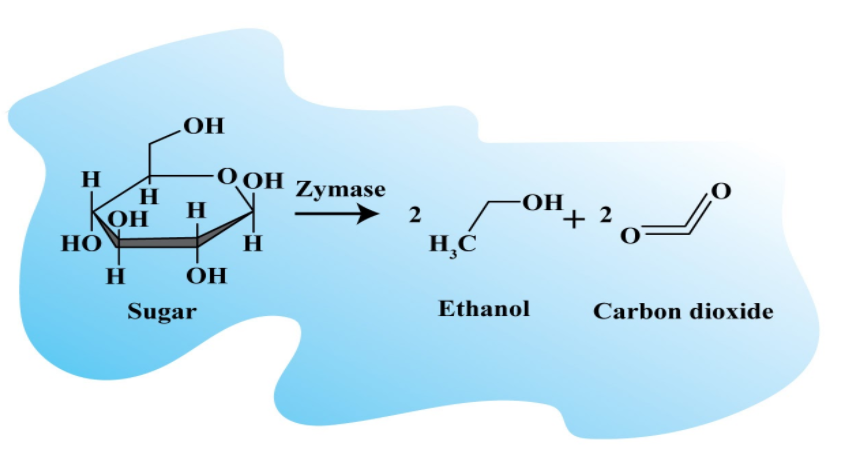
First discovered enzyme was
A. Isomerase
B. Transaminase
C. Zymase
D. Transferase
Answer
501.9k+ views
1 likes
Hint: They are the group I enzymes which are extracted from the yeasts and help in breaking sugar molecules into fermentation products.
Complete answer:
The first discovered enzyme was Zymase. It naturally occurs in the yeast and helps in fermenting the sugar molecules producing carbon dioxide and ethanol.
Additional Information:
-Enzymes are the biological catalyst that helps in carrying out the reaction at a faster rate.
-The enzymes are classified into six major classes: Oxidoreductases, transferases, Hydrolases, lyases, isomerases, and ligases.
-Oxidoreductases are the class of enzymes that help in the oxidation-reduction of add or remove the hydrogen and oxygen molecules.
-Transferases play an important role in transferring functional groups.
-Hydrolases help in adding the water.
-Lyases break the molecule by breaking the hydrogen bonds between them.
-Isomerases is the change in the position of a tome present inside the molecule.
-Ligases help in joining the two molecules with the help of the energy in the form of ATP.
-Different zymase types are found in different strains of the yeast.
-A drug named pancrelipase is the brand name of the zymase enzyme.
-Zymase was divided into two categories by the British chemist Sir Arthur Harden 1905. These varieties are: dialyzable and nondialyzable.
-Another enzyme present in yeast is invertase which converts sucrose into glucose and fructose.

So, the correct answer is ‘Zymase’.
Note: In 1897 the enzyme zymase was first isolated by a German chemist Eduard Buchner from the yeast cell. He won the Nobel Prize in 1907 for his experiments of fermenting the sugar molecule Prize in the living cells in the laboratory. According to some scientists, Buchner repeated the experiments done in 1857 by Antoine Bechamp. Later, K. L. Manchester informed that the enzyme in which Bechamp isolated was not zymase, in fact, it was an invertase enzyme.
Complete answer:
The first discovered enzyme was Zymase. It naturally occurs in the yeast and helps in fermenting the sugar molecules producing carbon dioxide and ethanol.
Additional Information:
-Enzymes are the biological catalyst that helps in carrying out the reaction at a faster rate.
-The enzymes are classified into six major classes: Oxidoreductases, transferases, Hydrolases, lyases, isomerases, and ligases.
-Oxidoreductases are the class of enzymes that help in the oxidation-reduction of add or remove the hydrogen and oxygen molecules.
-Transferases play an important role in transferring functional groups.
-Hydrolases help in adding the water.
-Lyases break the molecule by breaking the hydrogen bonds between them.
-Isomerases is the change in the position of a tome present inside the molecule.
-Ligases help in joining the two molecules with the help of the energy in the form of ATP.
-Different zymase types are found in different strains of the yeast.
-A drug named pancrelipase is the brand name of the zymase enzyme.
-Zymase was divided into two categories by the British chemist Sir Arthur Harden 1905. These varieties are: dialyzable and nondialyzable.
-Another enzyme present in yeast is invertase which converts sucrose into glucose and fructose.

So, the correct answer is ‘Zymase’.
Note: In 1897 the enzyme zymase was first isolated by a German chemist Eduard Buchner from the yeast cell. He won the Nobel Prize in 1907 for his experiments of fermenting the sugar molecule Prize in the living cells in the laboratory. According to some scientists, Buchner repeated the experiments done in 1857 by Antoine Bechamp. Later, K. L. Manchester informed that the enzyme in which Bechamp isolated was not zymase, in fact, it was an invertase enzyme.
Latest Vedantu courses for you
Grade 11 Science PCM | CBSE | SCHOOL | English
CBSE (2025-26)
School Full course for CBSE students
₹41,848 per year
Recently Updated Pages
Master Class 9 General Knowledge: Engaging Questions & Answers for Success

Master Class 9 English: Engaging Questions & Answers for Success

Master Class 9 Science: Engaging Questions & Answers for Success

Master Class 9 Social Science: Engaging Questions & Answers for Success

Master Class 9 Maths: Engaging Questions & Answers for Success

Class 9 Question and Answer - Your Ultimate Solutions Guide

Trending doubts
What are Quantum numbers Explain the quantum number class 11 chemistry CBSE

Who built the Grand Trunk Road AChandragupta Maurya class 11 social science CBSE

The reason why India adopted the policy of nonalignment class 11 social science CBSE

How much is 23 kg in pounds class 11 chemistry CBSE

The plastids which are coloured green and colourless class 11 biology CBSE

Earth rotates in which direction A East to west B West class 11 physics CBSE




